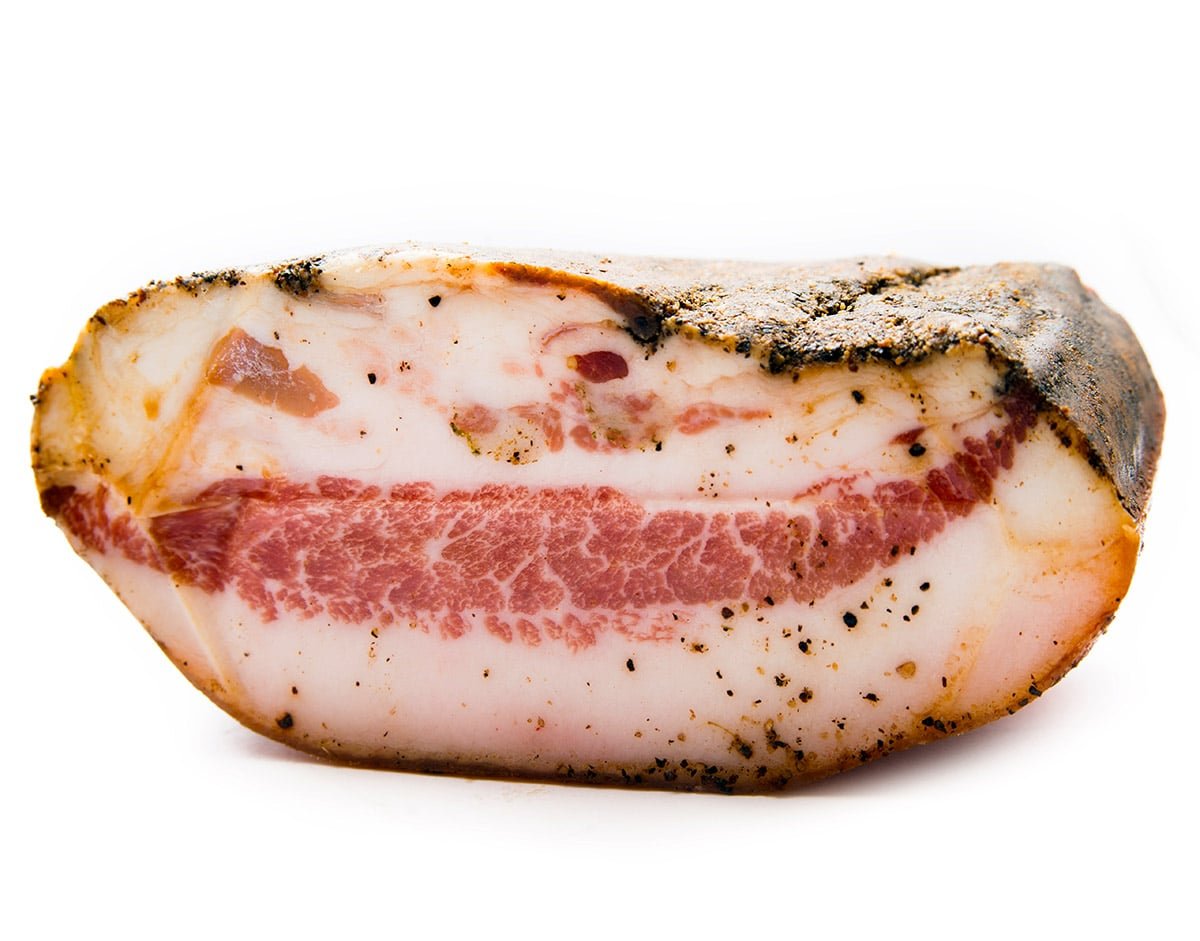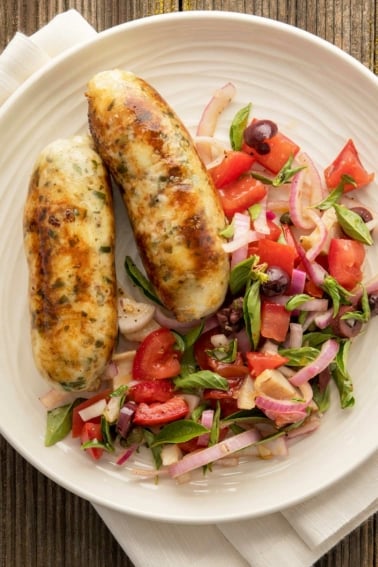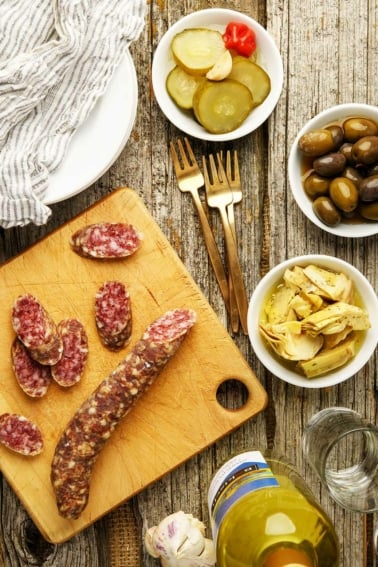As an Amazon Associate I earn from qualifying purchases.
Guanciale. Jowl bacon. Pig candy. I can’t remember the first time I had this magnificent pork product from Italy, but it was probably in some pasta carbonara I had back home in New Jersey; carbonara should, traditionally, be made with guanciale, not bacon. Ditto for spaghetti all’amatricana.

I’ve made guanciale many times, and I’ve referred to it on this blog for more than 15 years, so here’s my guanciale recipe.
Keys to making guanciale are salt, humidity and time. I also use Instacure No. 2, which has nitrates and nitrites, for added safety; you can buy Instacure online from Butcher & Packer. If you have a thing against using them, skip it.
A word on the salt. You need to weigh your meat in grams and then measure out 2.5 percent of that weight in sea salt or kosher salt, then another 0.25 percent – that’s one quarter of one percent – in cure no. 2, which contains sodium nitrate. I use Instacure No. 2.
My curing fridge set-up is this: An old refrigerator connected to a temperature regulator, which lets me control the temperature where the meat is hanging; you can buy these at homebrew shops. You will also, in most cases, need a humidifier to keep the air moist in the fridge. I have one connected to a humidity regular (available online) so I can ratchet the humidity down, week by week, from 85 to 90 percent down to 65 percent.
A general rule is you want the air to be about 5 percent drier than the interior of the meat. So start at 90 percent for the first couple days, then ratchet down 5 percent a week until you get to 55 to 60 percent, then hold it there.
So in short, you will need:
- A fridge, basement or other cool, dark place to hang your cured meat
- A way to control temperature, either in a permanently cool basement or with a temperature regulator
- A way to control humidity, either a humidifier, or, in some places, a dehumidifier. If you can control humidity in 5 percent increments, you can make a better product
- Patience
Guanciale, as with most cured meats, requires time to be really good. I started by curing mine for only 3 to 4 weeks, but now I prefer 12 to 16 weeks. The depth of flavor in a longer-cured guanciale is markedly better than one cured for a shorter period. You could go longer than 16 weeks, if you’d like.
Why bother making guanciale when you can make regular belly bacon? Because jowls work harder. They did an awful lot of chewing when Mr. Piggy was alive and any muscle that works hard tastes better, in this case, porkier. Guanciale, especially long-cured guanciale, will have a stronger, more pronounced flavor, than regular pancetta or bacon.
How do you use guanciale, which, by the way, is pronounced gwan-chee-AHL-ay? I prefer it in chunks with beans or pasta, or sliced thin as an antipasto or as part of a charcuterie plate. And yes, you can fry it up like bacon, but it will be so dry you will need to put a little water in the pan first to let some fat render; this prevents the meat from burning.
Guanciale, or Jowl Bacon
Ingredients
- 1 large hog jowl, skin on
- Instacure No. 2 (see above)
- kosher salt (see above)
- 1/3 cup sugar
- 1 tablespoon garlic powder
- 1 tablespoon crushed black pepper
- 2 teaspoons dried thyme
- 1 teaspoon ground allspice
- 5 or 6 bay leaves crushed
Instructions
- Mix all the cure ingredients together and pack the jowl with it. Massage the cure into the meat and fat. Put the jowl into a container (plastic, glass, ceramic, stainless steel) that just barely holds it, and toss in any remaining cure. Cover the container and put in the fridge for 4 to 7 days. Turn the jowl over once a day.
- When the meat has stiffened up at the thickest part, usually 5 days or more, rinse off the cure (you can leave a little on, but get most off), and pat the jowl dry. Put on a rack in a drafty place for several hours.
- Poke a hole through the skin on a corner of the jowl and tie string to it. Hang the jowl in a cool, moist place (50-55°F and at least 65 percent humidity, but see above for more curing instructions) for at least 3 weeks before eating. To store, cut into large chunks and vacuum seal or cover with plastic wrap and butcher paper before freezing. Guanciale will last, well-wrapped, in the fridge for several months.
Notes
Nutrition
Nutrition information is automatically calculated, so should only be used as an approximation.






Made 4 jowls worth after processing our mangalitsas. Pulled some out at 6 weeks recently, and it’s phenomenal. Made a legit carbonara and used it on pizza so far. Thanks for another awesome curing recipe
You really ought to change the recipe to work in 1000g amounts of pork and not on a “1 cheek” basis. They vary too much in size for it to be meaningful wrt to the other ingredients.
Question…. I’ve made guanciale a number of times with no issues, love the results… but today, I took four jowls out of the fridge after 7-8 days cure, and three were normal and one was still soft, on the fat side and on the skin/hide side? Never had that happen? Could I have possibly left something out? Pink salt? Salt? Can’t imagine I did, but this one piece never stiffened a bit? Thanks
I love the way my first attempt turned out, so Thanks!! Next up is refining my equipment and technique. I’ll be building a curing fridge, but first:
1) How much of the rub do you wash off before drying? All? All you can somewhat easily (quite a bit rubbed in)? Most?
2) One of the comments mentioned a gland to be removed, but I haven’t seen anything in your post about it – did I miss something?
JC: I just brush off the cure, leaving some on. And yes, buried in there is a gland. No need to remove it before curing and drying, but when you get to it while using the guanciale, you will want to cut it out and toss it.
British butcher by trade and as you can imagine I’ve heard it all and seen most of it too when it comes to meat prep and curing, I’ll say this was not something I’ve ever cured or produced myself, after a visit to Italy and trying some of the cured meats that aren’t quite as common here and considering pig cheeks here aren’t used or wanted much they’re often Just minced into sausage so I was chomping at the bit to try this and all i can say is thank you very much!!!! Absolutely ten out of ten!!! I’ve been I’m the meat trade now for just under 18 years and I have nothing but good things to say about this recipe and process, I would say for some people lacking experience in temperature control or a little overwhelmed by the instructions on humidity and temp… don’t overthink it or stress it too much and just give it a go, it certainly won’t kill you and you always have something to improve on even if your first try without being extremely strict on the numbers was t what you expected.
Hi Hank,
First, thanks for all of your recipes/processes- they’ve really helped to up my usage of the whole animal, with absolutely delicious results.
In the past, I’ve had really good success using dry aging bags for pancetta in the fridge. I’m trying it now with guanciale, and while I pre-weighed and am looking for about a 30% decrease in weight, what are your thoughts about using dry aging bags in a fridge vs. a dedicated curing fridge? I’m in southern Arizona, so humidity in any place other than a fridge is hard to come by. Thanks for any insight.
Hi Hank,
I have 2 questions for you about the initial processing for wild hogs. The hogs we generally harvest are between 80-150 lbs and the initial processing (taking hams, shoulders, etc.) are done in pretty rustic environments.
Question 1 – is there a simple way to remove the hair on the jowl after it was removed from the pig or would you remove the skin completely for the guanciale?
Question 2 – Do you remove the masseter muscle from the jowl or leave it on?
Matt: I leave the muscle on, and as for the hair, I pour boiling water over the area when the head is still intact (more or less) and scrape off the hair. Then I will singe what’s left, and scrape again, and then remove the jowl from the head.
It is expected to finish curing and be quite hard right? As in a little challenging to cut?
When cooking I assume it softens up or do you need to cut into (quite) small pieces for that to happen?
Bob: Yes, it should be quite firm.
Thanks for this recipe! My pork jowl from my local farmers market was pretty small. Less than a pound and about 431 grams. The amount of salt called for (according to the calculations in the notes) seemed reasonable. But the pink salt cure seemed way off. According to the website of the recommended brand, use 1 teaspoon per 5 pounds of meat. A quarter of a percent of 431 is about 107 grams which is ALOT more than the ~1/4 teaspoon recommended for a pound of meat. What am i missing? I admit that math is not my strongest subject! Since the pink salt seemed to be optional, I went with the much smaller amount. Also, sadly, my pork jowl came without skin. I’m hopeful that it will still work, but would love any guidance about that.
Milena: 1/4 of 1 percent of 431 grams is 1 gram, not 107.
Hank,
I have cured bacon in my garage refrigerator. Cure #1, dry cure, 40 degrees. Is it possible to make guanciale, using this method. If so, what timing would be necessary for success? I live in Florida so waiting till winter is not a choice.
Ken: Not really. You need long aging times for guanciale, and temperatures closer to 50F than 40F. What you can do is make Southern jowl bacon, which is this: https://honest-food.net/jowl-bacon-recipe/
Hi, I may have made some guanciale, quite a bit, even. My wife’s friend keeps some animals and I wound up with the jowls of a pig. I got a recipe off the internet, not sure which one, yours looks familiar. My root cellar was full so I hung them in a Little Chief smoker on the back porch all winter. Sure enough, when I got the nerve to look they were just disgusting, covered with mold. My problem is, they don’t smell bad at all. They smell good. I washed off what I could, they still look awful, and put them in the root cellar. Guess I’ll try some when nobody’s around. Any insight or advise about this?
Neal: It might be OK. Slice it and see. The interior of the meat will tell you.
Neal mentions that they were covered in mold.
Biggest question is: What color was it? That will tell you if it is safe.
Hank i have had my Guanicale in a fridge i modified to hang meat for a little over 4 weeks now . I cured for 1 week before putting the 3 jowls in . I just check noticed last night 2 of the 3 had a small amount of white mold both in a crevice area of the jowl . both the size of about a pea . I wiped them both off with a paper towel . should i have cut that small section out ? i also have noticed a week or so ago a white like powder on the top of the fridge where i mounted an internal fan . any suggestions would be helpful . thanks
Ethan – What did you end up doing? How did it turn out?
Hank – This is a beautiful article! Love the idea of making your own. However, I’m not in a position to do this. Our local store carries “country ham” unsmoked, salt & sugar cured, air dried pork products. They sell small 1 pound packets of salt cured hog jowls. Would this give me the flavor of guanciale in cooking? Often recipes say to sub pancetta, but it’s much leaner, and a belly product. What do you think of taking the cured jowls, and rubbing it with the herbs and spices that you use in your recipe, and “marinate” it in that for a week in the fridge? Thanks for your attention.
Catherine: Yes, a salted hog jowl is basically guanciale.
can i cold smoke the guanicale once i wash the cure off and pat it dry before putting it in my meat chamber ? thanks Hank
Ethan: Yes, you can. Not traditional, but tasty!
Hi i am not sure if you will be able to understand my question but i will go and ask.
I have a small biltong maker wuth a extractor fan in and i want to know if i can make guanciale in there. I also live in South Africa, Paarl Average temp. 32° in summer can reach 40s and in the winter its 17° can also reach higher. Will that be a problem making it. Also the biltong maker is not temperature controled just the extractor fan and also a dry lamp that can be removed.
Just pulled them out after 2 weeks in cure in fridge. They still don’t feel that stiff. Smell fine etc. can I just hang them in my meat curing fridge. I followed yours cure salt and regular salt percentage but not sure if it’s actually cured?
So it is supposed to get hard right? I followed recipe exactly and It didn’t seem like much curing salt?
I have followed this recipe and the meat has been 7 days but not hardening at all??? I did the .25 cure but not sure that was enough? Thoughts?
Carl: If you did a cure by weight, it will be fine to leave it there for another week.
Let me get this straight. When you said curing you meant drying? Whoa. That’s a horse or jowl of a different color. I’d correct that immediately. Thanks. So 4 day cure or 7 day cure? (It was the use of prague #2 that confused me as for this short of a cure you probably should have used #1 or nothing.) I am weighing the jowl down with my bacon.
What is your recommendation for smoking. 150F for 3 hours? Less?
I am giving this recipe a shot. I mixed the salts with the spices and rubbed it on the jowl. Is this incorrect? Thanks.
I also used the Ruhlman/Polcyn maple syrup bacon cure on some pork belly. I found it to be extremely messy. I will only be using maple sugar from now on and maybe the dark brown sugar.